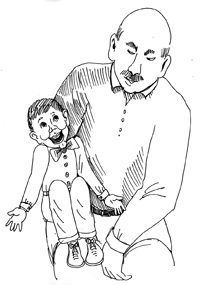STRANGEBUTTRUE- More McCarthyism: You may talk to a special nobody

Q. Do you ever find yourself talking to people who aren't there? –I. Stevenson
A. University of California researcher Ronald K. Siegel, author of Fire in the Brain: Clinical Tales of Hallucination, tells of a man named Steve whose pregnant wife had died shortly before a daughter was to be born, whom they had already named Star.
Steve lived alone but said he wasn't lonely, because he was in communication with Star's spirit. "She's three years old," he said– not "She would have been three years old."
She was born "on the other side" and could travel at will through time and space, and so visited him often. He saw her now clear as day, sandy hair like her mother, spoke to her, heard her words. She was the classic bereavement companion, a "typical hallucination suffered by people who mourn a loved one," says Siegel.
This communication is also a form of "channeling," well-known to New Agers who claim to contact spirits of the dead, like the Washington state housewife who says she channels a man who lived 35,000 years ago. Others talk of channeling John F. Kennedy, Rembrandt, or Jesus.
Siegel likens it all to an incident where ventriloquist Edgar Bergen was overheard talking– not rehearsing— alone with his wooden dummy Charlie McCarthy. The two were discussing matters of love and life when they discovered the eavesdropping visitor.
Obviously embarrassed, Bergen explained, "I was talking with Charlie, the wisest person I know." "But it was only your own mind responding," the visitor remarked.
"Well, I guess ultimately it is," allowed Bergen, "but I ask Charlie these questions, and he answers, and I haven't the faintest idea of what he's going to say, and I'm astounded by his brilliance– so much more than I know."
Q. Does the tail ever wag the dog? –R. Williams
A. In outer space or zero-gravity it can. A weightless dog floating in a space capsule would find that each wag "west" pushes her body slightly "east," and vice versa. Sir Isaac Newton talked of "equal and opposite reactions"; canine physicists prefer "wag and counterwag."
Q. Fifty years ago, prefrontal lobotomies were hailed as "revolutionary," a way of "surgically removing psychoses." For developing it, Portuguese physician Egas Moniz was awarded the 1949 Nobel Prize in Medicine. Then what happened? –T. Williams
A. Soon afterward, Moniz was shot by a disgruntled patient and confined to a wheelchair. The procedure didn't fare so well either: Designed to calm uncontrollable patients by disconnecting the frontal lobes from the emotion centers of the brain, lobotomies did far more than that to many, who suffered severe memory disorders, loss of facial expression, blunted emotions, or fell into a "vegetative state." Some even died.
Initially, lobotomies were viewed as a last-resort measure, but over time some practitioners became more casual about doing them. They were easy and cheap, taking only about 10 minutes: An icepicklike instrument was inserted through each eye socket into the brain, then wiggled to sever certain connective nerves.
By the early 1950s, some 40,000 such operations had been done in the U.S. alone, reports James W. Kalat in Biological Psychology. A large number were performed by Walter Freeman, a medical doctor never trained in surgery. He did many right in his office or at other non-hospital sites, carrying his equipment around in his "lobotomobile."
Amid growing controversy and with the advent of calming drugs in the mid-1950s, lobotomies fell into virtual disuse.
~
Send Strange questions to brothers Bill and Rich at [email protected].
#